Good morning! Hopefully you’ve already had some time to absorb the full suite of details on the new Aeroplan loyalty program, which will be launching on November 8, 2020.
If not, go browse through those details before we get started here – we will be going through the six “Key Facts” about the new flight rewards that we had outlined, in much greater detail.
Of all the changes that are being introduced, perhaps the most widely-anticipated changes are those relating to Aeroplan’s new flight rewards. How will the rules of the game be changing as of November 8, and which redemptions will be increasing or decreasing in value as a result?
With the award chart, fee structure, routing rules, and stopover policy all undergoing wholesale changes under the new program, there is a world of information for us to absorb. Let’s dive right in.
In This Post
- Understanding the New Flight Reward Chart
- Understanding Dynamic Pricing on Air Canada
- Old vs. New Charts – Economy & Business
- Old vs. New Charts – Negative Changes
- Old vs. New Charts – Positive Changes (New Sweet Spots!)
- Old vs. New Charts – Key Things to Know
- Old vs. New Charts – First Class
- Changes to Fees, Surcharges, and Stopover Policies
- Advanced: What About Mixed Journeys with Air Canada & Partner Airlines?
- Advanced: New Routing Rules
- The Booking Process
- Conclusion
Understanding the New Flight Reward Chart
Before we look at the numbers, we must first take some time to understand the nature of the new Aeroplan Flight Reward Chart, because it’s a significant departure from the simple geographic zone-based Aeroplan chart that we’re all accustomed to.
(If you’re like, “Ricky, I don’t care about the nature of the chart, I just want to know about the sweet spots and the devaluations!” – then feel free to proceed straight to our Old vs. New Chart comparisons below.)
The new chart divides the world into four geographic zones:
- North America – including Hawaii, Mexico, Central America, and the Caribbean
- South America
- Atlantic zone – including Europe, Western Russia, Africa, the Middle East, Central Asia, and the Indian Subcontinent
- Pacific zone – including East & South East Asia, Eastern Russia, and Oceania
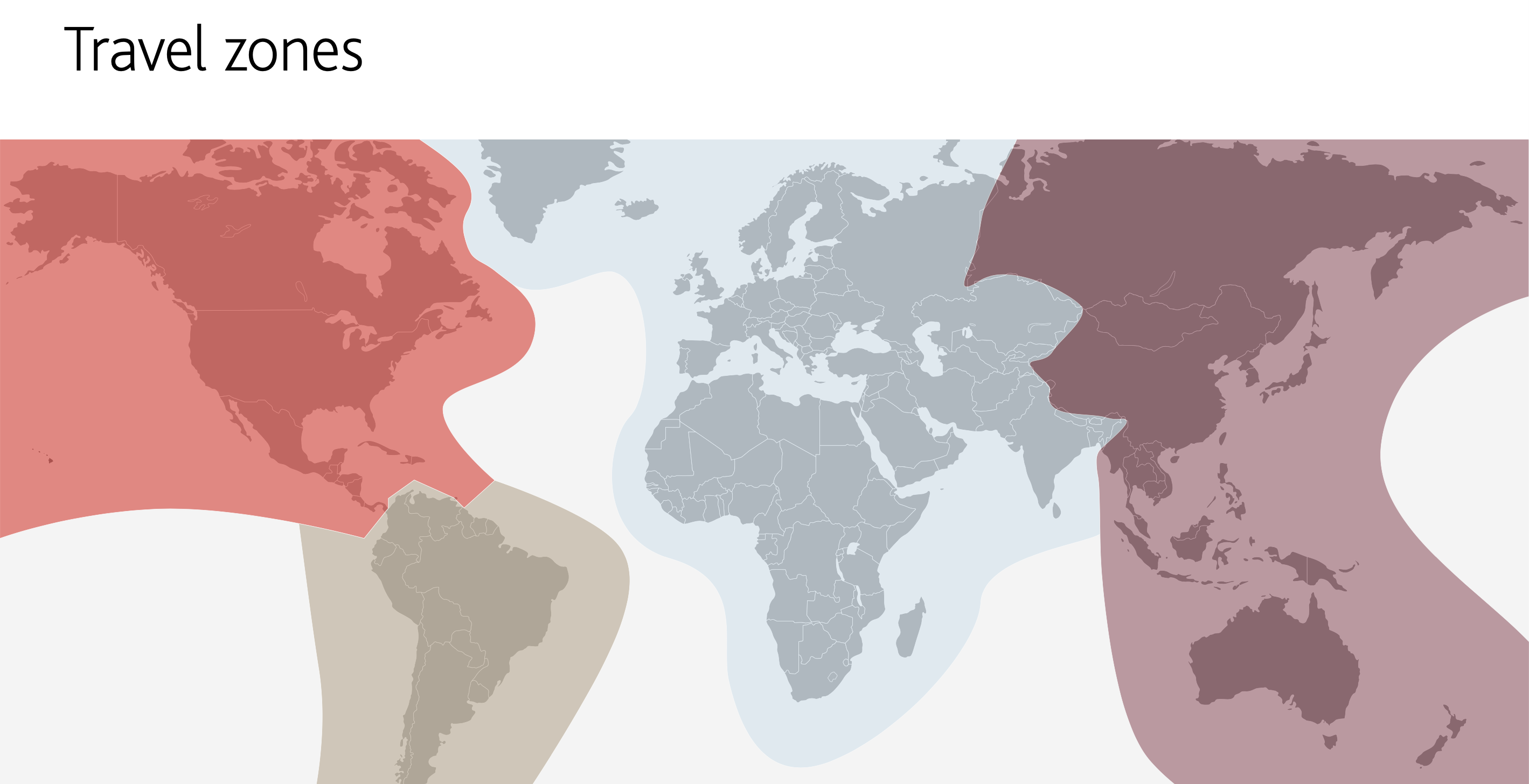
Among these four geographic zones, there are 10 distinct award charts, listed below alongside a few examples of journeys that would fall into each zone:
- Within North America: Toronto–New York, Vancouver–Miami, Panama City–Iqaluit

- Between North America and Atlantic zones: Montreal–Paris, Calgary–Johannesburg, Anchorage–Mumbai
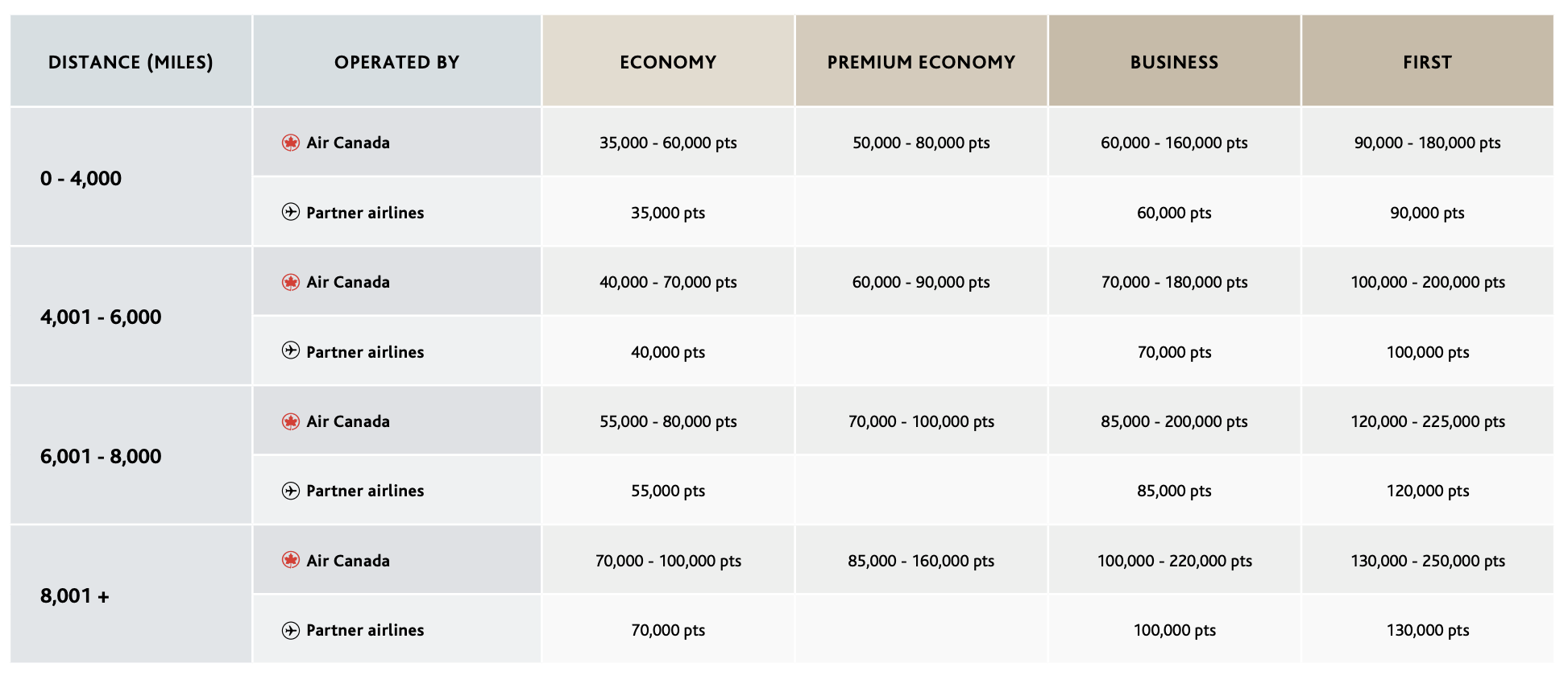
- Between North America and Pacific zones: St. John’s–Perth, Mexico City–Bangkok, Halifax–Singapore
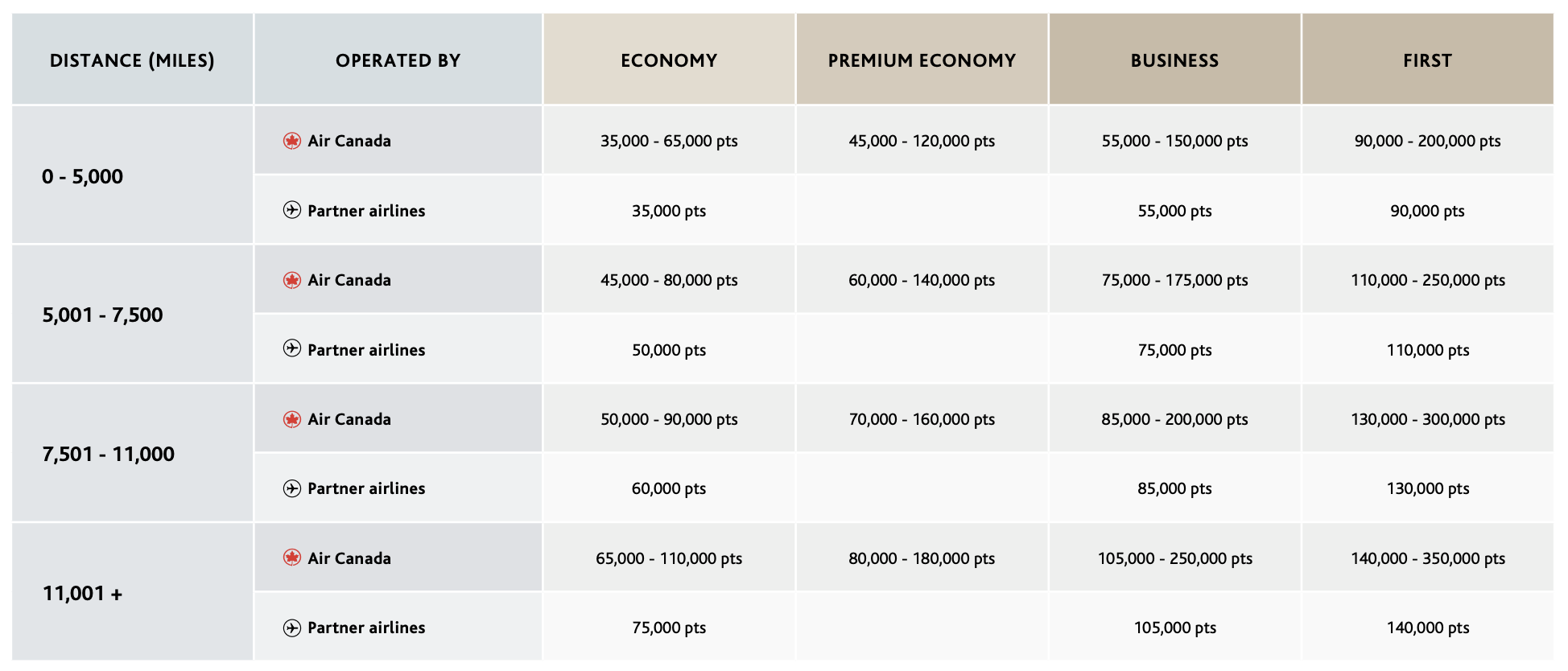
- Between North America and South America: Edmonton–Cuzco, Chicago–Buenos Aires, Victoria–Galápagos Islands

- Within Atlantic zone: Copenhagen–Zurich, Barcelona–Maldives, Marrakesh–Cape Town

- Within Pacific zone: Tokyo–Sydney, Beijing–Phnom Penh, Vladivostok–Auckland

- Between Atlantic and Pacific zones: Dublin–Christchurch, Nairobi–Guam, New Delhi–Taipei

- Within South America: Cartagena–Rio de Janeiro, Quito–Santiago, Lima–Foz do Iguaçu

- Between Atlantic and South America zones: Lisbon–Recife, Madrid–Medellín, Addis Ababa–São Paulo

- Between Pacific and South America zones: Shanghai–Bogotá, Seoul–Belo Horizonte, Manila–Georgetown

Next, each of these 10 separate award charts are then broken down into distance bands and classes of service.
The distance bands are listed along the left-hand side. Distance is calculated based on the total flown distance of your chosen routing: the more convoluted your routing, the greater the distance flown.
Importantly, the distance is also calculated cumulatively from the origin to the destination: you add up the distances of all the flight segments, and then look up the total against the chart (unlike a program like British Airways Avios, where each segment is priced individually and then summed up to arrive at a total price).
Then, you look up your desired class of service across the top of the chart. As before, the class of service for every “one-way bound” is determined based on the highest class of service among all flights on that bound, so even if you have only one flight in business class and five flights in economy class, the entire bound will be priced at the business class rate.
(Note: The concept of a “one-way bound” is not the same as a “ticket”; we will revisit the definition of a “bound” later in this article, as it’s a key concept that underpins Aeroplan’s new routing and ticketing logic.)
And finally, you’ll notice that the award charts involving North America will have two separate price points, depending on whether you’re flying with Air Canada or a partner airline…
Understanding Dynamic Pricing on Air Canada
Air Canada flights are subject to a dynamic pricing model, which will correspond to the given range of award prices on roughly 90% of occasions, while partner flights remain at the fixed levels.
In most (but not all) cases, the fixed price for partner flights corresponds to the lower bound of the range of prices for Air Canada flights, with the upper bound of the range set significantly higher.
As we discussed in our introductory guide to the new Aeroplan program, this reflects the fact that Aeroplan points will now be able to access all of Air Canada’s flight inventory, even the very last seat on a given flight, rather than only a space-restricted subset.
Importantly, Air Canada confirms that the amount of available seats that you see in today’s Fixed Mileage Rewards will be roughly on par with the amount of seats bookable at the lowest end of the published dynamic ranges in the future, on balance across the network.
In other words, if you’re usually able to track down Fixed Mileage Rewards on Air Canada flights that you’re happy with under today’s program, then you should generally still be able to book these same seats in the new program without worrying about having to pay the higher prices within the published ranges.
On the other hand, if you haven’t been able to book the Air Canada flights you want under the current program, then in the future you will be able to book these, albeit potentially towards the higher ends of the published ranges.
However, keep in mind that this balance applies across the entire Air Canada route network, rather than in specific markets. Among individual origin–destination pairings, some will tend to see lower pricing, while others will tend to see higher pricing – all depending on the underlying revenue fares.
To further flesh out this idea, let’s consider an example of a Toronto–Munich flight in business class (which clocks in at 4,138 miles):
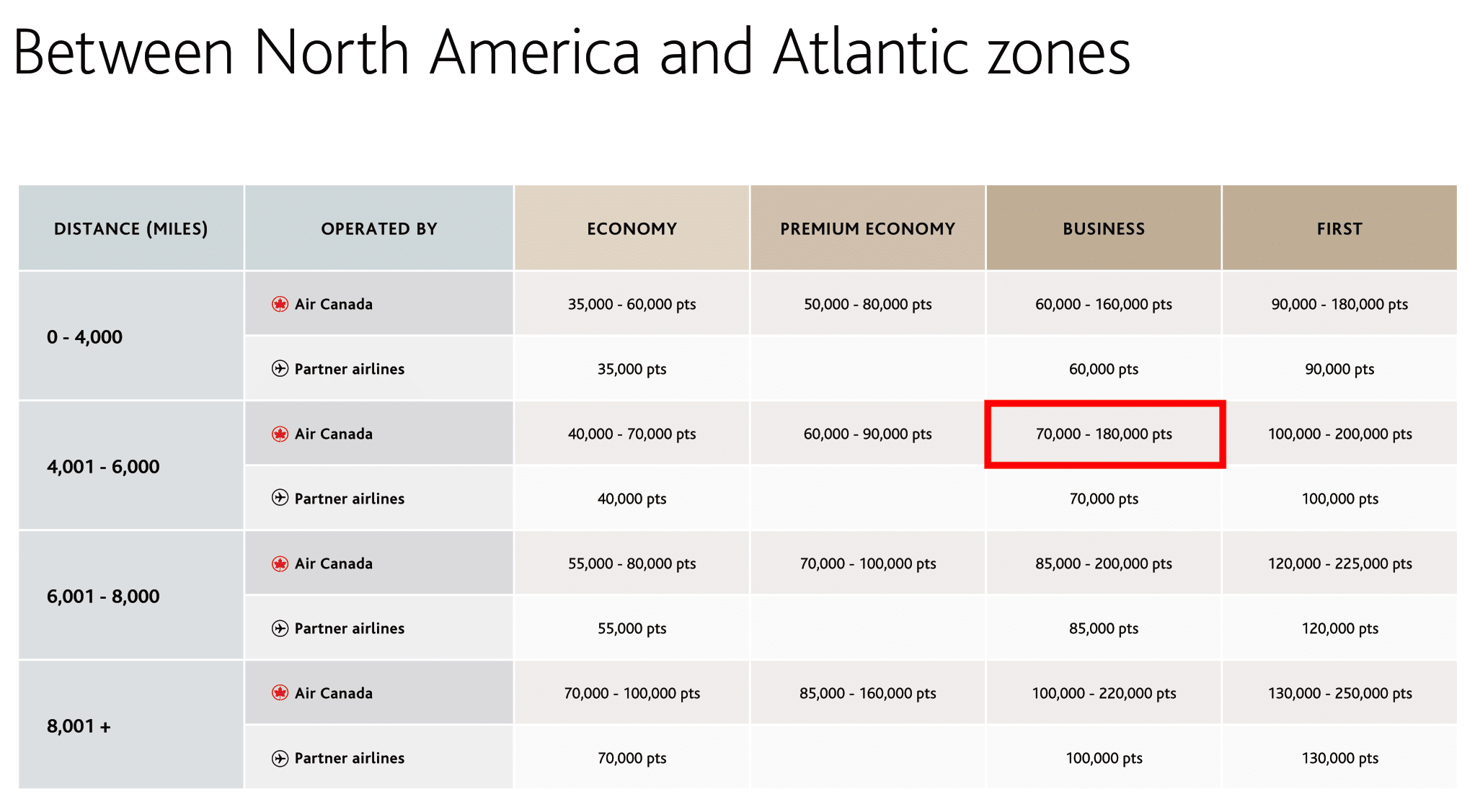
We see that the published range for Air Canada flights is 70,000–180,000 Aeroplan points. How would the dynamic pricing work in practice?
Well, if the business class cabin were wide-open, then there’s a good chance you’ll be able to book this seat for 70,000 Aeroplan points, at the very lowest end of the range.
On the other hand, if there were only a handful of business class seats left, and your award booking might cannibalize a seat that Air Canada could’ve otherwise sold for cash, then you might have to pay 160,000 or 180,000 Aeroplan points for the flight.
And if you were booking, say, the final unoccupied business class seat on any Air Canada transatlantic flight on Christmas Eve, then there’s a good chance you’d be charged even more than 180,000 Aeroplan miles for the award. This would be an example of the 10% of exceptions to the published range, as opposed to the 90% of occasions when the price should fall within the published range.
To summarize, on Air Canada flights:
The current Aeroplan's... | Corresponds to the new Aeroplan's... | Allowing you to book... | Example for |
Fixed Mileage Flight Rewards | Lower bound of published price range | Limited number of seats | 70,000 |
Market Fare Flight Rewards | Published price range | Every available seat | 70,000–180,000 Aeroplan points |
Finally, note that Aeroplan Elite Status members and co-branded credit card holders will receive “preferred pricing” in Air Canada’s dynamic pricing model.
There are no published, predictable rules for how the preferred pricing will work; rather, these members are simply more likely to see prices at the lower end of the published ranges.
On this point, Air Canada emphasizes that engagement with the program via either co-branded cards or Elite Status will make a very meaningful difference to the dynamic reward prices that members see on Air Canada flights.
As a rule of thumb, the higher your status or the higher-tier your credit card, the stronger the effect of preferred pricing will be; meanwhile, members who hold both Aeroplan Elite Status and a co-branded credit card will receive a double-boost.
Old vs. New Charts – Economy & Business
Due to the change in the fundamental nature of the award chart, it can be difficult to compare the old and new award charts head-to-head to assess how good or bad these changes are.
In order to properly compare, we’ll use Vancouver, Calgary, Toronto, and Halifax as our four “control points”, and we’ll pinpoint the change in redemption prices for one-way itineraries between these four origin cities and all of the following domestic and international destinations:
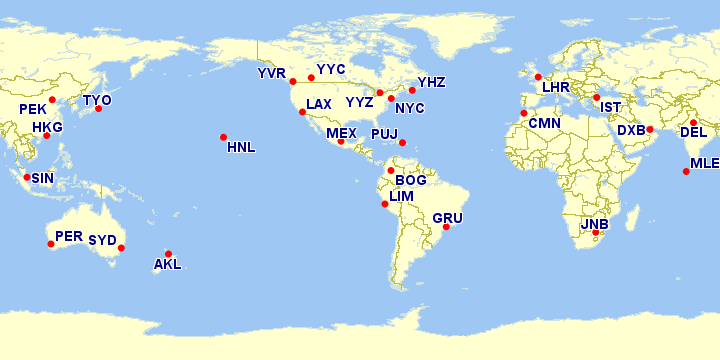
For simplicity’s sake, we will compare the current Aeroplan reward prices against the lower bound of the Air Canada price range under the new reward chart; in most cases, the latter also corresponds to the fixed partner price for an equivalent redemption.
We’ll also assume the traveller taking the most direct routing possible, given Star Alliance’s regular pre-COVID-19 route network.
Without further ado, here is the complete comparison chart below. Each cell consists of three items: the chosen routing between origin and destination, the change in one-way economy class pricing from old to new, and the change in one-way business class pricing from old to new.
Favourable changes are denoted in green, unfavourable changes in red, and neutral or offsetting changes in black.
Vancouver | Calgary | Toronto | Halifax | |
North America | ||||
Vancouver | – | Direct | Direct | Via YYZ |
Calgary | – | – | Direct | Direct |
Toronto | – | – | – | Direct |
New York | Direct | Direct | Direct | Direct |
Los Angeles | Direct | Direct | Direct | Via YYZ |
Honolulu (HNL) / Maui (OGG) | Direct | Direct | Direct | Via YYZ |
Mexico City (MEX) | Direct | Via IAH | Direct | Via EWR |
Punta Cana (PUJ) | Via YYZ | Via YYZ | Direct | Direct |
Atlantic zone | ||||
London | Direct | Direct | Direct | Direct |
Istanbul | Direct | Via LHR | Direct | Via LHR |
Casablanca | Via YUL | Via YUL | Via YUL | Via YUL |
Dubai | Via YYZ | Via YYZ | Direct | Via YYZ |
Johannesburg (JNB) | Via LHR | Via LHR | Via LHR | Via LHR |
Maldives | Via TPE, SIN | Via NRT, SIN | Via IST | Via LHR, IST |
New Delhi (DEL) | Direct | Via YVR | Direct | Via LHR |
Pacific zone | ||||
Tokyo | Direct | Direct | Direct | Via YYZ |
Beijing | Direct | Via YVR | Direct | Via YYZ |
Hong Kong | Direct | Via YVR | Direct | Via YYZ |
Singapore | Via TPE | Via NRT | Via TPE | Via LHR |
Sydney | Direct | Via YVR | Direct | Via YYZ |
Auckland | Direct | Via YVR | Via YVR | Via YYZ, YVR |
Perth | Via NRT | Via NRT | Via NRT | Via LHR, BKK |
South America | ||||
Bogotá | Via IAH | Via IAH | Direct | Via YYZ |
Lima | Via IAH | Via IAH | Direct | Via EWR |
São Paulo | Via IAH | Via IAH | Direct | Via EWR |
Old vs. New Charts – Negative Changes
My first impression from the comparison chart is that there’s certainly lots of red: the costs of many award redemptions are increasing compared to before, especially for international travel.
We can see that the largest increases (in the range of 30–40%) generally seem to affect travel between North America and the Atlantic zone, particularly the Middle East, Africa, and Indian Subcontinent. Travelling to certain parts of South East Asia, Oceania, and South America will get more expensive as well.
This isn’t a surprise when we consider that the current Aeroplan award chart has not undergone a devaluation since 2014, and the underlying costs for Air Canada to support partner flight redemptions has no doubt increased in the meantime.
In fact, Air Canada states that the net devaluation we’re seeing here corresponds to less than half of the increase in real underlying costs for their partner redemptions over the past six years, as calculated based on true data on all the the partner redemptions that Aeroplan members had booked in the year of 2019.
So yes, we’re seeing a lot of red – but things could’ve (and arguably should’ve) been a lot worse too.
- Read more: New Aeroplan: What to Book Before November 8
Old vs. New Charts – Positive Changes (New Sweet Spots!)
At the same time, there are a few noteworthy green spots, representing decreases in the award costs and increases in value.
The award rates for Mexico, Central America, the Caribbean, and Hawaii were relatively high under the current chart, which means we now see some very satisfying reductions in the new award chart for travel to these regions.
(12,500 points one-way from Vancouver to Hawaii? Yes, please!)
Moreover, the partially distance-based nature of the award chart results in a few very intriguing sweet spots when the distance flown clocks in just underneath one of the thresholds.
For example, check out the new redemption price point for the Vancouver–Tokyo direct flight: currently this prices at 75,000 Aeroplan miles in business class, but in the new program, it’ll only be 55,000 Aeroplan points! That’s a spectacular deal for a redemption with ANA business class or Air Canada business class on that route.
A similar situation is happening with flights from Vancouver to Auckland on either Air Canada or Air New Zealand, which will now cost only 75,000 Aeroplan points (compared to 80,000 miles before), as well as the direct Vancouver–Brisbane route which similarly clocks in at just underneath the 7,500-mile threshold in the North America–Pacific award chart.
(Of course, if you’re originating in Canadian cities other than Vancouver, then you’ll be flying a greater distance and will likely overshoot the distance threshold, negating the sweet spot.)
Let’s summarize here a few of the most notable routes that are decreasing in cost from a Canadian traveller’s perspective (all of which are subject to the choice of routing):
- Short-haul flights of fewer than 500 miles will now cost 6,000 Aeroplan points in economy class, decreasing by 25%.
- Flights of fewer than 1,500 miles, which were previously classified as long-haul North America redemptions (e.g., Toronto–Halifax, Vancouver–Los Angeles), will now cost 10,000 Aeroplan points in economy class or 20,000 Aeroplan points in business class, decreasing by 20% each.
- Major Canadians cities to Mexico will now cost 12,500 Aeroplan points in economy class or 25,000 Aeroplan points in business class, decreasing by 38% and 17% respectively.
- Central & Eastern Canadian cities to the Caribbean will now cost 12,500 Aeroplan points in economy class or 25,000 Aeroplan points in business class, decreasing by 38% and 17% respectively.
- Vancouver to Hawaii will now cost 12,500 Aeroplan points in economy class or 25,000 Aeroplan points in business class, decreasing by 44% and 38% respectively.
- Rest of Canada to Hawaii will now cost 17,500 Aeroplan points in economy class or 35,000 Aeroplan points in business class, decreasing by 22% and 13% respectively.
- Toronto or Montreal to Casablanca will now cost 35,000 Aeroplan points in economy class or 60,000 Aeroplan points in business class, decreasing by 13% and 27% respectively.
- Vancouver or Calgary to Tokyo will now cost 35,000 Aeroplan points in economy class or 55,000 Aeroplan points in business class, decreasing by 6% and 27% respectively.
- Vancouver or Calgary to Auckland will now cost 75,000 Aeroplan points in business class, decreasing by 6%.
- Vancouver to Brisbane will now cost 75,000 Aeroplan points in business class, decreasing by 6%.
- Central & Eastern Canadian cities to Peru will now cost 50,000 Aeroplan points in business class, decreasing by 9%.
Of course, for Air Canada flights, all of the above is assuming the lower bound of the published range of prices; as mentioned above, these prices will be available in similar numbers to how many Fixed Mileage Rewards are available on Air Canada in today’s program.
However, there will also inevitably be occasions when you search for Air Canada flights and only see higher prices being displayed, because all of the lower-priced seats have been booked up already.
Old vs. New Charts – Key Things to Know
We can see that the new award chart includes a mix of negative and positive changes compared to before. Now let’s try to think about a few big-picture truths about the new award chart that we should keep in mind.
Given the hybrid zonal and distance-based nature of the new award chart, we can see that the value of a given redemption will now be much more sensitive to your home city, as well as your chosen destination.
West Coast residents will find it relatively cheaper to visit Asia than Europe compared to their East Coast counterparts, and vice versa, simply due to the shorter distance flown.
In addition, the other broad lesson we can see is that the routing plays a key role in the pricing: if you fly a routing that’s more complex than the most direct route, you’ll likely end up paying more miles.
For example, look at the box in our comparison chart representing travel between Halifax and Lima. This box is green if we route via Newark, but if we routed via Toronto instead, it would be red – the routing would cross into the next distance band, bumping up the award cost.
Finally, the hybrid nature of the award chart opens up some interesting possibilities when it comes to making two separate bookings instead of one.
Consider an itinerary of Vancouver–Tokyo in business class, followed by Tokyo–Seoul in economy:
- If we’re booking this as one award, we look at the “Between North America and Pacific zones” chart, find the distance band (5,001–7,500 miles) and the class of service (Business) to identify the price of 75,000 Aeroplan points.
- If we’re booking this as two separate awards:
- For Vancouver–Tokyo, we look at the “Between North America and Pacific zones” chart, and find the distance band (0–5,000 miles) and the class of service (Business) to identify the price of 55,000 Aeroplan points.
- For Tokyo–Seoul, we look at the “Within Pacific zone” chart, and find the distance band (0–1,000 miles) and the class of service (Economy) to identify the price of 8,000 points.
- In total, we’ll only pay 63,000 Aeroplan points, saving 12,000 Aeroplan points in the process.
Old vs. New Charts – First Class
Now, while the above comparison was focused on economy class and business class, another key consideration among savvy Aeroplan members is the ability to redeem points for aspirational First Class flights.
To examine how First Class prices are changing, the below table focuses on the key routes for Etihad Airways, Lufthansa, ANA, and Thai Airways – arguably the four best First Class products we can book with Aeroplan miles.
The first seven rows represents flight between their respective cities and the airlines’ hub airports listed across the top row. Meanwhile, the final four rows indicate redemptions between the specified points, connecting through the hub airports on First Class all the way. Each cell represents the change in one-way First Class pricing from old to new.
Abu Dhabi (AUH) | Frankfurt | Tokyo | Bangkok Thai Airways | |
New York | 105K to 120K | 70K to 90K | 105K to 110K | – |
Los Angeles | 105K to 130K | 70K to 100K | 105K to 110K | – |
London | 60K to 65K | – | 105K to 100K | 110K to 100K |
Paris | 60K to 65K | – | 105K to 100K | 110K to 100K |
Seoul | 87.5K to 80K | 105K to 100K | – | 55K to 60K |
Singapore | 87.5K to 80K | 110K to 100K | – | – |
Sydney | 125K to 130K | – | – | 95K to 60K |
New York (JFK) | 140K | 105K to 130K | 105K to 130K | – |
London (LHR) | 105K to 130K | 105K to 100K | 105K to 100K | 105K to 130K |
New York (JFK) | 110K to 140K | – | – | – |
London (LHR) | 130K to 130K | – | – | 130K to 130K |
As you can see, there’s plenty going on here.
It’s a shame, but not surprising, that some of Aeroplan’s most popular aspirational redemptions will be going up in price: Lufthansa First Class to Europe will now cost at least 90,000–100,000 points one-way, while the famous New York–Abu Dhabi–Sydney redemption on the Etihad Airways A380 First Class Apartments will rise from 110,000 miles to 140,000 points.
Conversely, a few First Class routes between Europe and Asia will get marginally cheaper, while Bangkok–Sydney on Thai Airways First Class is starting to look like quite a compelling sweet spot after a 37% decrease to 60,000 points.
Changes to Fees, Surcharges, and Stopover Policies
Besides the award chart itself, there are a few more very exciting changes to the overall flight rewards ecosystem.
We’ve covered the major changes to the redemption fee structure in our introductory guide to the new Aeroplan, and they are summarized in the following table:
Fee type | Old Aeroplan | New Aeroplan |
Carrier-imposed surcharges | Up to $500+ per direction | $0 |
Partner award booking fee | N/A | $39 |
Contact centre booking fee | $30 | $30 |
Stopover allowance / fee | One complimentary stopover on a round-trip | One stopover on a one-way (excluding travel within Canada/US), for an incremental 5,000 Aeroplan points |
Change fee | $100 ($75 for Aeroplan Diamond members) Free for Altitude Super Elite 100K members | $75 until 60 days prior to travel date ($25 on Economy Flex bookings) $100 within 60 days of travel date Free for Latitude/Flexible bookings Free for Aeroplan Super Elite members |
Cancellation fee | $125 if cancelled online ($30 for Aeroplan Diamond members) | $150 if cancelled online ($75 on Economy Flex bookings) |
Infant award fee | Economy: $50 or 5,000 Aeroplan miles, per ticket | Travel within Canada/US: Taxes and fees only |
The elimination of carrier-imposed surcharges is no doubt the most groundbreaking change here, and indeed one of the headline items of the new program as a whole.
Yes, there are some devaluations to the Flight Reward Chart, but when you consider that carrier-imposed surcharges on all flights will now be $0 (including Air Canada, Lufthansa, Austrian Airlines, Air China, Canadian North, etc. – all of the previous “worst offenders” when it came to surcharges), the set of reasonable redemption options available to Aeroplan members has in fact been greatly expanded!
Consider, for example, New York–Frankfurt in Lufthansa First Class. Would I pay an extra 20,000 points for this redemption, from 70,000 to 90,000 points, in exchange for no longer having to pay the $900 carrier-imposed surcharge on this flight? You bet I would!
And when it comes to getting to your destination in the most convenient fashion, you will no longer have to avoid Air Canada flights and their crazy surcharges!
No more crazy routings via Asia to get to Australia, or traipsing through the US and then Switzerland to get to London – unless you want to, of course!
Now, obviously, Air Canada knows that the carrier-imposed surcharges were nothing more than a cash grab, which they will be losing out on going forward. As a small measure to offset that loss, they have added a $39 partner booking fee for any ticket (i.e., an overall itinerary under a single PNR, per passenger, not per direction) that contains a flight on a partner airline.
I’m certainly not happy about this change, but when positioned against the context of the elimination of $500+ in fuel surcharges, I can accept it, and I suspect most Aeroplan members will feel the same.
The other noteworthy change in terms of the fee structure lies in the change and cancellation fees, and are also summarized in the below chart by Air Canada:
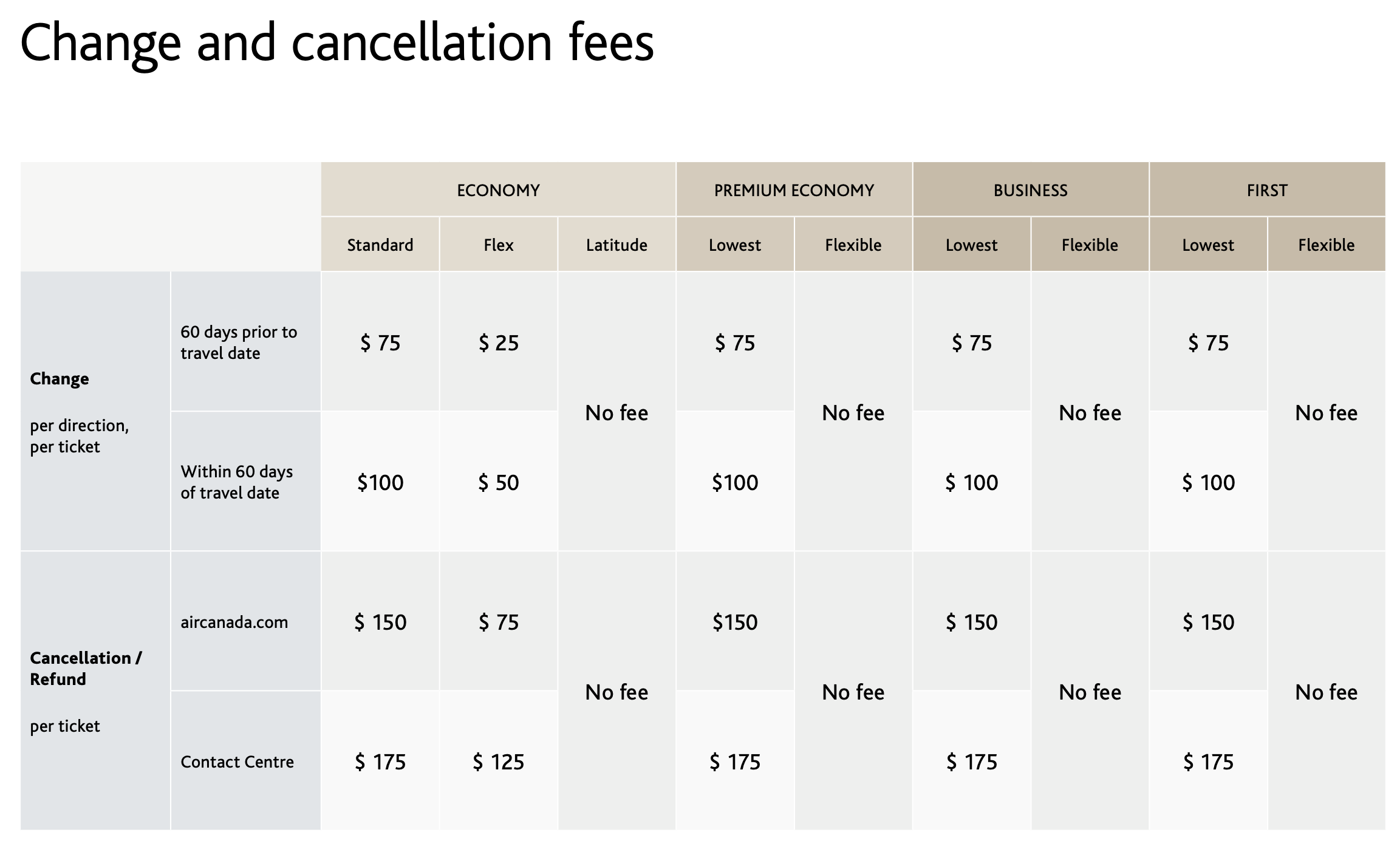
The change fee has been restructured around the date of making a change: changes made 60 days prior to travel will be cheaper than changes made within a 60-day timeframe.
Meanwhile, the cancellation fees (both online and over the phone) have been bumped up slightly. For those who are looking for added flexibility in their award tickets in terms of change and cancellation fees, it may be worthwhile to pay the points premium for the higher fare families of Flex or Latitude (for economy class) or Flexible (for other cabins). We’ll learn more about the exact pricing patterns of these higher fare families when the new program launches.
Finally, instead of allowing one free stopover on a round-trip flight, Aeroplan will now allow one paid stopover on a one-way flight (excluding flights within Canada and the US), for an incremental 5,000 Aeroplan points.
This means that if you were booking a round-trip flight, then you’d be able to add a total of two stopovers – reminiscent of the Aeroplan Mini-RTW in its original form – for an incremental 10,000 Aeroplan points.
(However, stopovers are no longer permitted on journeys wholly within Canada and the US, which is a devaluation compared to the current program.)
When we consider all of these changes in their totality – the award chart, the dynamic components, the fee structure, the stopover policy, etc. – I think the new Aeroplan’s flight rewards are about as competitive as we could’ve hoped for.
We all expected that some kind of devaluation was going to come to the award chart, but in my view, the elimination of all fuel surcharges really softens that blow, and the allowance for a stopover on a one-way flight adds another very welcome layer of flexibility to the program as well.
Advanced: What About Mixed Journeys with Air Canada & Partner Airlines?
The new Flight Reward Chart includes the following footnote: “Points required for itineraries combining both Air Canada and partner airline flights may vary.”
Well, how exactly is the price determined if Air Canada and partner flights are combined on the same one-way booking?
(This is a fairly advanced topic, so feel free to skip ahead if you don’t take any interest in the nitty-gritty details of award pricing.)
I’m sure many Aeroplan users have experienced the following frustration at some point: you’ve pieced together your ideal business class flights on some awesome Star Alliance partners, but then you’re unable to find any space on that last Air Canada flight to get you home.
You have to either accept an awkward overnight layover or book an entirely separate flight to get home – even if there’s an Air Canada flight you could catch, it just doesn’t have any award space.
Well, now that the new Aeroplan program can access all Air Canada seats, you’ll be able to combine that Air Canada flight as long as there’s an empty seat on it. However, if partner flights are fixed and Air Canada’s revenue space is dynamic, how does the overall itinerary’s pricing work?
The answer is that it will be calculated as a weighted average based on the respective distances flown on Air Canada and on partner airlines.
Let’s consider an example: you live in Winnipeg and would like to travel to Lisbon in business class. You’ve found space on the Toronto–Lisbon flight on TAP Air Portugal, as well as a Winnipeg–Toronto Air Canada flight that arrives just before the TAP flight departs. However, that Winnipeg–Toronto flight was nearly full, and you’ve grabbed one of the last seats available.
Looking at the “Between North America and Atlantic zones” chart, we see that Winnipeg–Toronto–Lisbon, a journey of 4,513 miles, would price as follows in business class:

The fixed partner price is 70,000 points, while the dynamic price range for Air Canada flights is 70,000–180,000 points.
Now, since you grabbed one of the last seats available on the Winnipeg–Toronto, Air Canada will calculate what the dynamic price would’ve been for your entire Winnipeg–Toronto–Lisbon journey if we imagine that the whole thing was operated by Air Canada. Let’s say this dynamic calculation results in a total of 150,000 points, near the upper bound of Air Canada’s published range for this redemption.
Of course, you didn’t actually book Toronto–Lisbon on Air Canada; you booked it on TAP Air Portugal. So now we calculate the weighted average between 150,000 points (what the price would be if the whole thing were on Air Canada) and 70,000 points (the actual fixed partner price), using the respective flight distances as our weights.
Winnipeg–Toronto is 937 miles, while Toronto–Lisbon is 3,576 miles, so the calculation looks like this:
(937 / 4,513) * 150,000 + (3,576 / 4,513) * 70,000 = 86,609
The redemption will cost 86,609 Aeroplan points – a small premium over the fixed price of 70,000 points in exchange for accessing the limited number of seats left on your preferred Winnipeg–Toronto flight.
Of course, if you’d rather not pay that premium, you can always look for Winnipeg–Toronto flights that are less space-constrained (and therefore priced towards the lower end of the dynamic range).
(Incidentally, this is also why the Flight Reward Chart lists a range of prices for Air Canada flights under First Class, even though Air Canada doesn’t operate First Class. These ranges will be used in the calculations when Air Canada flights in lower classes of service are combined with partner flights in First.)
Advanced: New Routing Rules
Let’s briefly go over the new Aeroplan’s routing and fare combination logic. We’ll delve into this topic in greater detail when analyze the future of the Aeroplan Mini-RTW in an upcoming post.
As you can tell from the award chart, the new Aeroplan program operates on the basis of “one-way bound” pricing, rather than round-trip pricing. If you need to book a round-trip, it would simply be treated as two separate one-way bounds, priced individually and summed together (though not necessarily priced the same, since you might take different routings between the outbound and the return).
Remember, each of these one-way bounds can have a stopover for 5,000 Aeroplan points, which means that we will once again be able to book two stopovers on a round-trip – albeit at an added cost of 10,000 Aeroplan points.
What about open-jaws, you might ask? Remember that an “open-jaw” refers to the practice of flying into one city and out of another on the same ticket, with the intention of making your own way between the two points on separate transportation.
The answer is that there’s no ability to add open-jaws in the middle of a one-way bound, but you’re free to add open-jaws between one-way bounds. This means that you can’t have an open-jaw on a single one-way award – you’d need to book at least a round-trip (two one-way awards) to slot an open-jaw in the middle.
And what about long layovers of up to 24 hours (or up to 12 hours within Canada and the US)? Good news: those will still be allowed without counting as a stopover, and you’ll still be able to customize your routing to choose your preferred long layovers.
Now, here’s a bit of surprising good news: unlike the current Aeroplan program, you are not limited to two one-way bounds, or two “directions”, on the same “ticket”.
You can in fact add a third, fourth, fifth, or sixth one-way bound or “direction” on the same ticket, and the total price of the ticket would simply be all of your one-way fare bounds priced individually and summed together.
Remember, each of these one-way bounds can have an extra stopover for 5,000 Aeroplan miles, so in theory you could book an Aeroplan ticket that has extended stops in a total of 11 places (five “points of turnaround” and six stopovers) – you’d simply have to pay the cumulative award pricing for all six one-way bounds, as well as an incremental 30,000 Aeroplan miles for your six stopovers.
Furthermore, under the current Aeroplan program, the concept of maximum permitted mileage (MPM) governs “how far you are allowed to fly”, or, to be more precise, how convoluted your routing may be between your origin and your destination. Every city pair is assigned an MPM figure, and a one-way journey between these two cities is not allowed to exceed this figure in distance flown.
Air Canada has stated that the new Aeroplan program will no longer use the MPM concept to enforce routing restrictions. Instead, a given routing will be permitted on a one-way bound as long as it is “logical”.
Although the definition of a “logical” routing has not been specified as precisely as the old MPM rules, Air Canada has given us a general rule of thumb: for long-haul itineraries, if a routing gets to be 100% over the direct distance between two points, then the itinerary is no longer logical and will be broken into multiple fare bounds, instead of a single bound.
You’ll quickly realize that this is in fact more generous than the old MPM rules.
For greater clarity, Air Canada has offered us a few examples of permitted one-way routings, which might not have been permitted under the old Aeroplan MPM:
- Vancouver (origin)–Sydney (stopover)–Bangkok (destination); 69% above the direct distance
- Newark (origin)–Cape Town (stopover)–Addis Ababa–Bangkok (destination); 76% above the direct distance
- Toronto (origin)–London–Johannesburg (stopover)–Singapore (destination); 56% above the direct distance
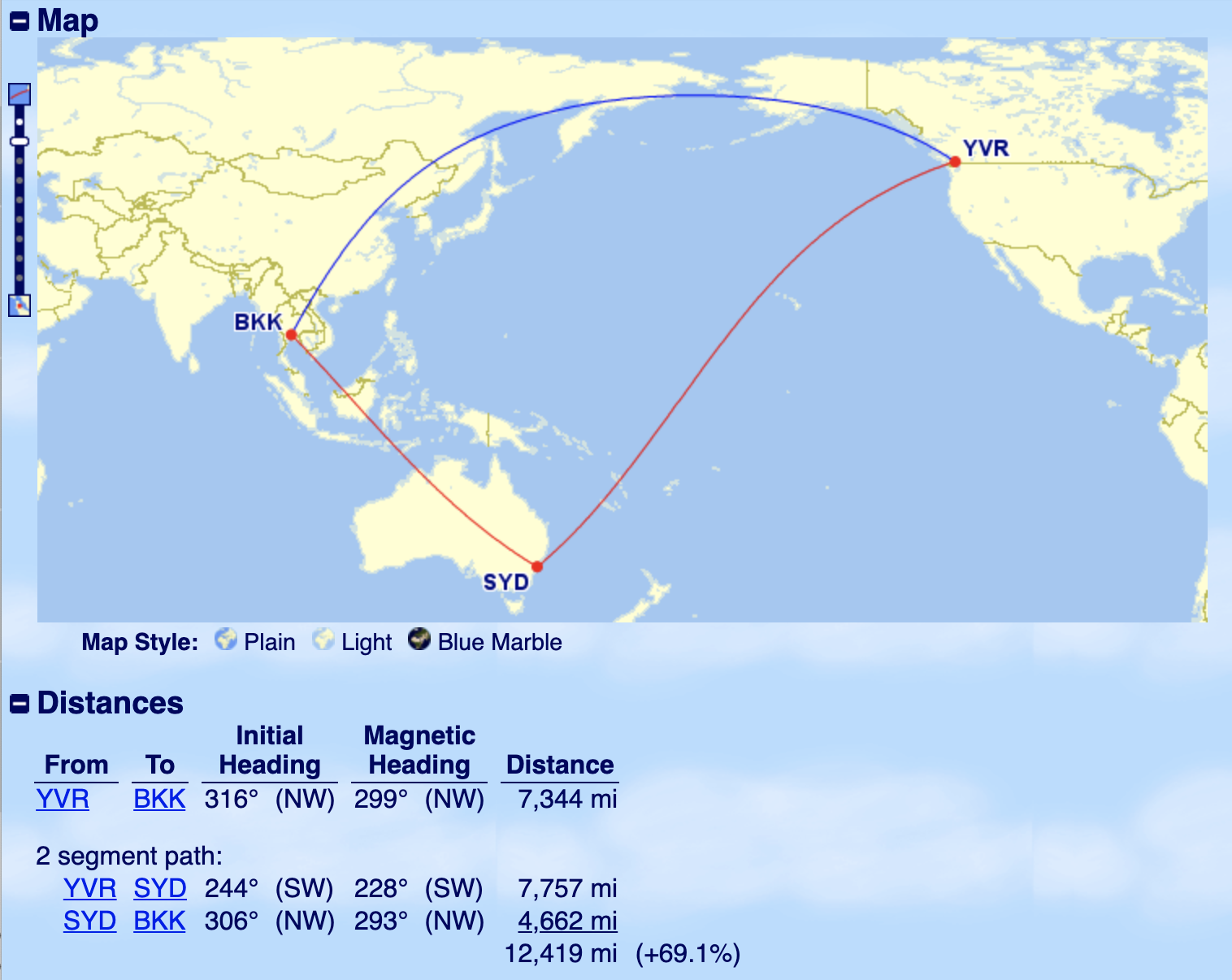
All of these would be bookable for 75,000 or 105,000 Aeroplan points in economy class or business class, respectively, plus 5,000 Aeroplan points for the stopover.
Air Canada also confirmed a few examples of routings that are not logical in the new program, and would therefore be priced as two separate awards rather than a single award:
- New York–Abu Dhabi–Frankfurt; 157% above the direct distance
- Toronto–Tokyo–London; 249% above the direct distance
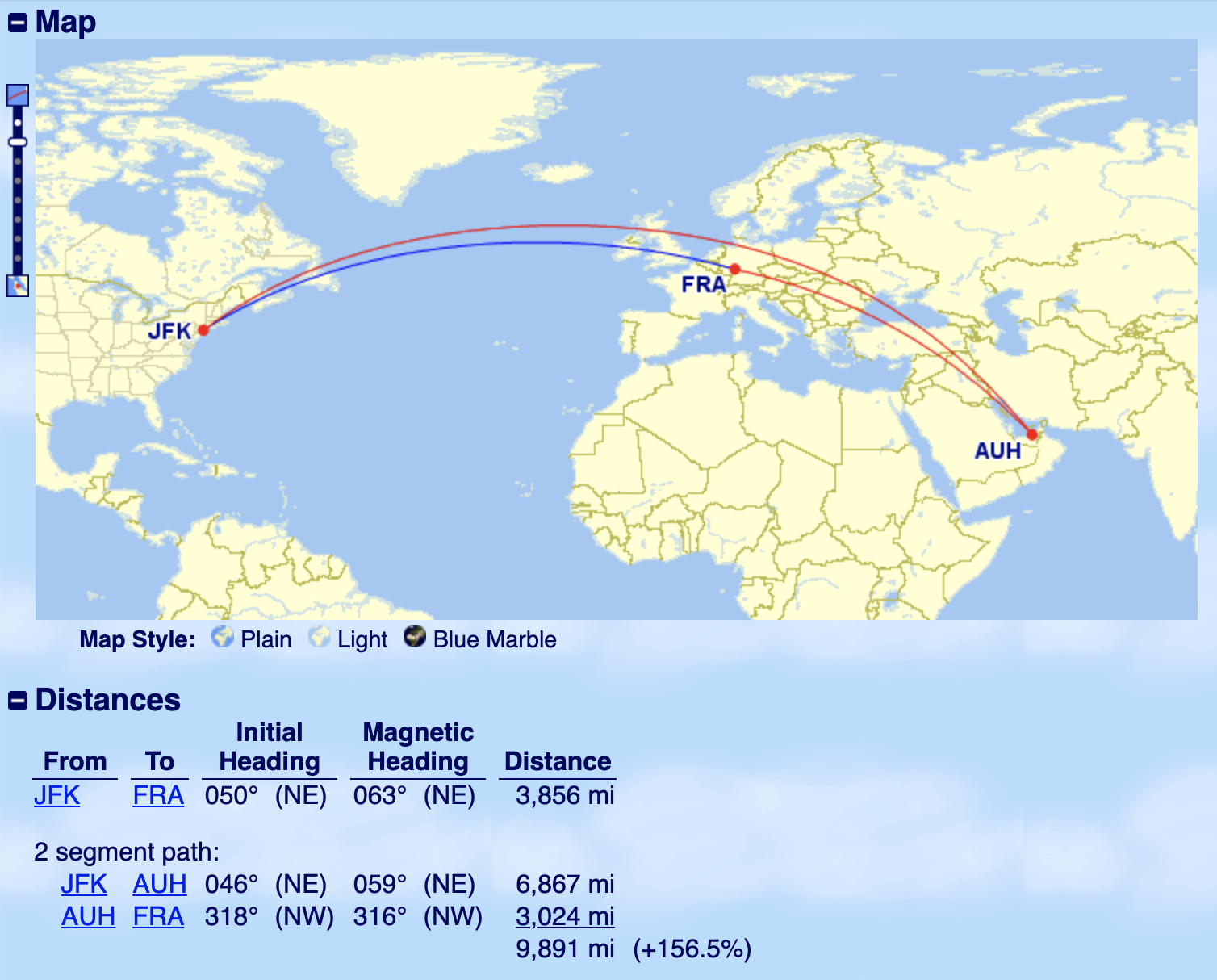
As I mentioned, we’ll get even further into the weeds on this topic in an upcoming post.
In the meantime, whose mind is already spinning with all the possibilities for extensive round-the-world travel, now that we can have stopovers on one-ways and customize our routings to our heart’s content?
The Booking Process
Finally, I wanted to talk about what the online booking process for flight rewards will be like after the new Aeroplan program launches as part of the Air Canada website on November 8.
The details we’ve covered in this post will help you understand how Aeroplan’s pricing works behind-the-scenes. However, the vast majority of Aeroplan members, who simply want to find out how many points they should expect to save up for their desired trip, will be able to use Aeroplan’s Points Predictor Tool to get a straight answer without having to grapple with 10 award charts and online mapping software.
Similarly, when members search on the Air Canada website for trips that they can book with their points, the search engine will return up to 150 results that encompass all the logic we’ve mentioned in this article, all sortable and filterable by a variety of criteria, just like when you’re shopping for revenue flights.
There’s no need to drown yourself in all of the calculations we’ve done in this article if you simply want to get decent value out of your Aeroplan points – but the option is always available to those of us who’d like to truly optimize.
One much-needed improvement to the search engine will be the ability to search with IATA city codes (“YTO” for Toronto, “NYC” for New York, etc.), and the search results will include inter-airport transfers as well. No longer will you need to call the contact centre and incur a $30 phone booking fee just because you need to fly into LaGuardia and out of JFK.
After the member selects a flight at a price point that they like, the next screen will allow them to choose between different fare families, as we outlined previously. Members will be able to upgrade to Flex or Latitude (for Air Canada economy), Latitude only (for partner economy), or Flexible (for other classes of service) to benefit from specific perks, such as a waiver on change and cancellation fees.
(Remember: Flexible fares in Air Canada business class will provide access to the exclusive Air Canada Signature Suites in Toronto and Vancouver, which was previously off-limits to points redemptions.)
Then, the following screen will provide the user with Points + Cash options (a feature we’ll explore more in an upcoming post), and finally, the member will be able to either input their credit card information or used a saved card in their Air Canada app to complete checkout.
When the new program first launches, the ability to piece together customized multi-segment routings, as we alluded to earlier, will only be available through the Aeroplan contact centre.
However, Air Canada states that this functionality will be rolled out online by 2021, allowing members to book as complex a trip as they wish (including stopovers), all online.
This sounds very exciting in theory, but hey – I’ll believe it when I see it!
Conclusion
The new Aeroplan’s flight rewards will be much-transformed compared to the current rewards structure that we’re all used to. As an exercise, feel free to come up with a sample routing and see if you can identify the correct reward pricing based on the new charts.
In light of all the buildup and anticipation around the new Flight Reward Chart, with many observers predicting brutal devaluations across the board, I’d say we made out alright in the end.
Given that the lower bound of the dynamic pricing for Air Canada flights will be available in roughly similar quantities as today’s Fixed Mileage Rewards, we can say that the changes to the Flight Reward Chart are generally more favourable for travellers within North America (especially to Mexico and Hawaii), while the increases in price have hit certain international destinations like Africa and the Middle East relatively harder.
However, the elimination of fuel surcharges will significantly soften this blow, and the ability to have a stopover on a one-way for an incremental 5,000 miles also promises to be a hugely valuable benefit.
I’m already salivating at the thought of making some epic redemptions under the new Aeroplan – but only after I’ve locked in a few favourable awards before the transition happens, of course!
















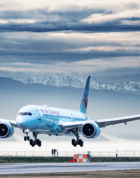



What tool do you guys use to make these trips? how can i find the layovers and stopovers? I have 400k in AMEX points I want to convert and do one or two epic trips… But I get lost in the searching on bookings process.
Canceled a booking but the points were not immediately credited back to my account.
Hi Ricky, on a round trip flight from YVR to YSB (through YYZ), I have redeemed 25k miles, and usually pay about $160 CAD in fees/taxes. With the elimination of the fuel surcharge, are you saying that this cash amount will be reduced, after the new program begins? I need to book this route for Christmas, and I’m wondering if I should book before, or after the change. Cheers!
Isn’t current YYZ to SIN 77,500 and not 75,000? So it’s not as bad as it looks.
Hi Ricky, great article as always. My wife and I (and an expected newborn) are looking at flying YYZ-ICN (Seoul) direct on business class in May 2021. Under the old Aeroplan, the only airline with direct availability is Air Canada. As a result, this would cost 300,000 points + $600 in carrier surcharges in total. Would you recommend that I lock this in now or that I wait until Nov 8 and book under the new Aeroplan (and avoid the $600 surcharge)? I’m leaning towards waiting for the new Aeroplan but I’m not sure if I’m missing something.
In the new program, this would still cost 150,000 points round-trip, without the surcharges. So it’s definitely advantageous to wait.
Excellent article Ricky. Maybe I’ve missed this somewhere in your reporting but what is happening to the Aeroplan tier status (silver, diamond, etc) which offered reduced points required on the market fare option? Low point options were often available between YYC – LHR. Will such deals still be available? Thanks.
The old Aeroplan status will only be converted into Aeroplan 25K status at a maximum. In the future, these low-point options will be replaced by “preferred pricing” on Air Canada flights under the dynamic model for credit card holders and Elite Status members. It remains to be seen how generous these discounts will be.
What if you already have 25K status and Aeroplan Diamond? Is it still only a maximum of Aeroplan 25k?
does anyone know if bookings made on the current basis will be honored after November 8, and further if you change one of these bookings after that date, will the change be based on the current system. As an example, if I book a flight from Calgary to Frankfurt today, for travel next March, will I be able to change it in February for the same flight at a later date without incurring a points penalty or any cash charge other than the change fee
Bookings made before Nov 8 will be honoured. However, changes made after Nov 8 will be subject to the new rules, not the old rules. The exception is in the case of involuntary schedule changes made by the airline.
Does anyome know if yyz-yvr-akl-sin-sgn or yyz-yvr-akl-sin-han is a valid routing under the new aeroplan program?
Both are under 100% the direct distance, so they should be good. Given that the “100% rule” is only a general rule of thumb, the former (+73.5%) strikes me as more likely to be valid than the latter (+97.7%).
Thanks. And changing HAN or SGN to HKG would be over mileage right?
Or maybe this will work – I was also thinking yyz-lax-akl-sin-hkg
That’s 98%, so again, in theory it should work but it’s just at the boundary.
Do you know if svx in Russia will be in the Atlantic or the Pacific zone? Looking at the colors on the map it seems to be the Pacific. TK flies there from IST. Typically it’s counted as Europe in most programs (ua, lifemiles, delta, aa).
Any idea if this would be logical one-way route. It’s way less than 100%, and it would even stay in the same bracket – so 85+30k for business?
Canada(Yul,yyz)-Germany-France-Italy-greece-Turkey-India-Thailand
This would be over the six-segment limit on a one-way bound. Also, there are no Star Alliance flights between France and Italy.
Yeah, Yekaterinburg looks like it’s in the Pacific zone to me.
It looks though like the Elite 25K status we get after racking up 100,000 points with a credit card cannot be used to reach higher tiers more quickly.
I have 2020 diamond status and when I look at my Altitude dashboard right now it shows Elite 25K status but the dials for both SQM and SQD don’t show anything credited there. It says I still need 35k/4000$ to get to Elite 35K.
Any indication otherwise?
No indication otherwise. That’s how it’s meant to be. There’s no shortcut to reach 35K, 50K, etc.; you’d still need to earn the SQM/SQS/SQD.
The best article i ever read on this new AeroPlan
Hi Ricky,
Thank you for the detailed post. This is certainly a lot to digest, and honestly I feel a tad overwhelmed. I should probably take enough time to digest all eventually!
I anticipate that I will be using up my Aeroplan points when booking a trip between Halifax and Seoul to see my family, preferably in business or higher due to the length of the trip. Comments seem to indicate Atlantic Canadians are getting the short end of the stick, so I suppose this kind of trip is no exception? I still hope that there are some sweet spots I can take advantage of under the new program…
Now imagine writing it 😉
Atlantic Canadians will be hoping for the YHZ-LHR and YYT-LHR routes to return eventually, in order to make use of those routes without paying YQ and benefiting from the distance-based chart from their locale. Going to Asia though, yes the prices will be going up, unfortunately.
Hi Ricky,
I have a question about multiple one-way bounds combination: Do you have to get back to the original city at the end of the itinerary?
Taking your example in the article, can I do YVR-SYD-BKK; SIN>JNB>LHR>YYZ as a valid itin?
Thanks
Yes, that would be valid.
Sorry if I missed this, but I only see one chart indicating the points needed for each mile range for trips between North American and Atlantic zones. Where can I find the other award charts for travel between NA and the other zones?
Hi David, it was my oversight that I hadn’t included all the award charts in the original post. All 10 charts are now included.
Thank you! Just finished reading everything you’ve published these past few days! Your effort in writing all of this up is really appreciated.
My pleasure! There’s certainly lots of information to digest. 🙂
Great article as usual.
I’m still trying to grasp all of the effects.
At this point I think all of the redemption changes are very negative if one lives in Newfoundland. Am I correct or am I reading that wrong?
I’d agree with that – Atlantic Canadians feel short-changed – at least until the normal route network including YYT-YHZ, and YHZ-LHR, and YYT-LHR are restored.
So far, I like it! However, one thing comes to mind. Atlantic Canada residents seem to be getting short changed (again?). Any Eastern Hemisphere travel usually requires a connection through YUL or YYZ. Since we’re going with distance, this could potentially add up to 1200 miles (eg, YYT – YYZ connection), which would bump up the required redemption miles, I mean, points. Also, YYT had it’s connection through YHZ but AC has cut most of the regional flights to YHZ from NB. So, YYT flight is now a connection through YUL or YYZ. Again, a higher rate of redemption. It would be nice if these factors could have been brought into consideration. How can we get this feedback to them?
Hi Duane,
I agree with your assessments that Atlantic Canadians are short-changed – at least until the normal route network including YYT-YHZ, and YHZ-LHR, and YYT-LHR (that was still around before COVID right?) are restored. I’d encourage you to share your feedback here: https://www.aircanada.com/ca/en/aco/home/aeroplan/feedback.html
Only because it’s left us pretty stranded we should note that it’s been longer than since Covid.
YYT-LHR disappeared after the MAX planes started dropping out of the sky.
Westjet also discontinued YYT-DUB.
how to check flight distance between home and destination?
try either of these
https://www.gpsvisualizer.com/calculators#form:range_rings
https://www.greatcirclemap.com/?routes=
the bottom one allows you to type in a route and comes back with combined distance
Great Circle Mapper: gcmap.com
A guide to using this app will be coming very shortly, that’s for sure.
Since we will be booking into different fare types (Flex for example) would we then be able to use our eupgrades similar to a paid far ?
Yes, all Aeroplan redemptions on Air Canada will now be eligible for eUpgrades.
Thank You Ricky for spending great deal of time in writing this article!
I have one question perhaps the same question from many others who are expecting to take the Etihad first class from SYD-AUB-JFK for 100000 miles one way without a stopover, with the new reward rule how many miles and fees will this ticket be, and if it is worth to get a stopover with extra 5000 miles? Trying to see if I should cancel the existing booking and rebook with the new reward rule. Thanks!
SYD-AUH-JFK is actually 110,000 miles right now. Take a look at the “First Class” section in the article – it’ll be 140,000 points in the new program, plus 5,000 points if you want a stopover.
Up to you if the extra stopover is worth 35,000 points to cancel and rebook!
I meant 110000 miles one way
As my eyes glossed over reading Ricky’s fantastically detailed info and comments from others, me thinks I am going to pay for someone to do the hard work for me….lol! I’ve only ever booked award flights on easy peasy routes and I barely had a handle on the old Aeroplan bef the new Aeroplan showed up. I have to say a lot of you folks are amazing to have grasped the Aeroplan game so well and share with us all.
So, lets see YYZ-AUH.
I can route YYZ-AUH-NRT-SIN-AUH (since its less than double the distance?) – and pay the mileage required for the highest 11000+ miles band?
Under the strict 100% rule, this would fall under, but keep in mind AC stated this was a “general rule of thumb” rather than a strict rule.
If it were allowed, you’d pay the 8,001+ distance band for North America–Atlantic.
ooops YYZ-ORD-NRT-SIN-AUH
So disappointed by the new flight rewards value.
My typical roundtrip route YYZ to GRU will now cost at least 80,000 points on economy, which today is what I would pay for a Premium Economy seat. On the other hand this same route involves taxes of $377, so if later I the the only costs is $39, that means I’m being forced to pay for taxes using points at the cost of 0.0169 cpm. No idea if this is a good deal or not but doesn’t seem like it.
That’s an interesting way of thinking about it. 1.69cpm is neither terrible nor outstanding, although keep in mind you’ll still need to pay the regular taxes and fees (like airport fees), just not the carrier-imposed surcharges.
Hi Ricky,
So i have a routing question. What if I route from yow-ewr-puj-bog-clo-mde-ctg-pty-sjo-yyz
All layovers of less than 24hr
GCMAP:6352miles
Will I need just need 22500 pts . Will it be considered 1 way as no MPM is there now
One-way bounds are limited to six segments now, unless the overall itinerary is a round-trip or multi-city.
Also, while there’s no MPM figure, illogical routings between two points still won’t be allowed. The general rule of thumb provided is that a routing is no longer logical if it’s over 200% above the direct distance.
thanks
This wouldn’t work. You have over 6 segments and the distance for calculation is yow-yyz, which is 226 + within 100% = 451 miles. I doubt that routing is under 451. I am pretty sure you will be charged two one ways on the NA-South America chart.
thank you. I reread the advance routing part.
Wrong on so many levels. Did you read the post? Have you ever redeemed an aeroplan point? How in the world do you think this is possible? Ricky, do not answer this fool.
Sorry for pinching your nerve. You could do yow-ewr-puj-bog-clo-mde-ctg-pty-sjo
under old rules as total MPM was below the yow-sjo limit. Now that the new chart just had fixed points above 2751 miles within North america, I wanted to ask Ricky if there is a loophole. Cleary I missed his advance routing section and spent more time on the aeroplan charts. Loopholes like these have existed in other point programs. Etihad’s redemption on Maroc air is one example.
Thanks RIcky for all this info! Looking forward to tomorrow’s article on complex routing.
Two questions right now (maybe they’ll be covered tomorrow?)
1. Which chart is used if a ticket crosses multiple zones? For example, from YYZ to GRU would cost 60,000 points in business, but if I go YYZ-LIS-GRU, would it still cost 60k or would it be 100k because it looks at the furthest zone travelled?
2. For a route like EVA’s TPE-VIE via BKK, would the distance be calculated as TPE-VIE direct or TPE-BKK-VIE?
Allow me to get back to you on #1. But then again, maybe this is one of those situations where we should give it a go ourselves when the new search engine arrives. 😉
For #2, I’m disagreeing with Alice here – it should be the direct distance TPE-VIE for the purposes of calculating the distance, as long as you’re booked on a single flight number (and therefore BKK is listed on your itinerary only as a technical stop). This is how every loyalty program has done it, including the current Aeroplan when calculating MPMs.
Ricky for #2, am I missing something? We use TPE-VIE to calculate distance to piece together a valid itinerary, but we use TPE-BKK-VIE to calculate culminated distance traveled to know how many points will be deducted.
I think he’s asking about EVA Air Flight 61/62, which makes a stop in BKK between TPE-VIE. If someone is booked on TPE-VIE on this flight number, then it’s the TPE-VIE direct distance that counts for calculating the routing distance.
Yes, that’s what I meant. Thanks for the clarification!
From everything that I have read so far, it seems what is logical, so no backtracking.
1. Origin – destination. So for this, it would be NA-South America chart, 60k points. You can route YYZ-LIS-GRU as that would fall under the permitted miles (YYZ-GRU being 5075, so your total segments need to be under 10,149 total).
2. For the purpose of valid itinerary, it would be TPE-VIE. For how many points you will be deducted, it will be TPE-BKK-VIE. So this would be Atlantic-Pacific region chart. You would pay 50,000/80,000 points for this in economy/business.
Thanks Alice! For number 1, this has to certainly be one of the huge sweet spots? We would basically be adding an extra segment from Atlantic to South America for no cost at all (YYZ-LIS 60k, LIS-GRU 80K if booked separately).
Sorry Dan, seems I am mistaken. Someone asked a similar question on the other blog and yyzbarista said it violates the IATA zone rules. Sure enough, when I tried to do a multi city cash fare, it says I need 3 separate tickets. So, maybe not. Sorry to get you all excited.
Ah well, no worries! I figured it is probably too good to be true. But as Ricky suggested, I will definitely still try it out when the new search engine comes out.
“Importantly, Air Canada confirms that the amount of available seats that you see in today’s Fixed Mileage Rewards will be roughly on par with the amount of seats bookable at the lowest end of the published dynamic ranges in the future.”
How does this relate to the “preferred pricing” for Aeroplan credit card holders? Is that additional inventory? Or does that mean if you don’t have an Aeroplan credit card, you’ll see LESS availability at the low end than you see in fixed price awards now?
It’s all the same inventory; however, it just means that Aeroplan credit card holders and Elite Status members may see the occasional “discount” on the same seats compared to what regular members might see. These discounts can even bring the pricing below the published price range, just as they can go above the published price range too in a combined ~10% of instances.
Sorry, I’m still not clear here.
Is Aeroplan taking these “discounts” into account when they make their claim that (roughly) the same amount of available seats will be at the low end of the dynamic pricing vs fixed mileage seats today?
If the answer is YES, then that would suggest that if you *don’t* have one of these cards, you’ll see LESS availability (without paying a premium) than you do now.
If the answer is NO, then that would suggest that if you *do* have one of these cards, you’ll see MORE availability (without paying a premium) than you do now.
While the claim was made in a general sense, AC also emphasizes that engaging with the program via credit card ownership and earning status will make a meaningful difference towards how likely a member is to see prices at the lower end of the range, compared to, say, the middle of a range.
Everyone sees the same amount of availability but what you pay depends on your elite status and/or having an AC affiliated card because having those will give you a “discount”. It is the same concept as the current market fare. We all see the same ability, but the person who has diamond status will pay less miles then the one who has black, silver or no status.
Let me give an example.
Let’s say for a particular flight, there are 10 seats available for fixed mileage rewards.
AC’s claim leads me to believe that there ought to be the same 10 seats available at the lowest end of the dynamic pricing under the new program.
Will everyone see those 10 seats and be able to book them?
Or will non-cardholders see only, say, 5 of them (meaning you’d have to choose a different flight if you don’t want to pay more)?
Everyone will see those 10 seats and be able to book them.
Any words on Star Alliance Upgrade Awards?
Excellent Article Ricky. Thanks to the May promotion on elite status, all four of my family members are elite, and sitting with miles in their account – looking forward to the new “family pooling” option and the pricing discounts based on elite status and holding credit card.
It looks like the points needed to do a mRTW to Asia / Australia in business class have increased significantly. If I wanted to do a trip of this nature in 2021… should I try to book one before November 8?
Yes, I would say so. However, you’d be able to do two stopovers after November 8, as opposed to one now.
You can but keep in mind that any changes you make post November 8 will be subject to the new program policies, regardless on when the ticket was booked. So no placeholder itineraries.
What if the change is involuntary? i.e. due to IRROPS?
Saw this answered below, please ignore. Thanks for such an informative article Ricky.
Argh that’s actually a big killer. I want to book a mRTW (and probably still will) but a big part of that has always been about swapping out for award space as they become available.
Great article, Ricky! Some pretty exciting stuff here.
My heads spinning. Lots of info. Thanks Ricky for the great write up.
I love this new award redemption, it is so flexible. I have so many thoughts swirling in my head and can’t wait to play around with the new program. Australia and New Zealand will be easier to get to now. So much fun to play with, I’m excited!
“but only after I’ve locked in a few favourable awards before the transition happens, of course!” AC is on to us, I thought I read somewhere that any changes made after November 8 will be subject to the new rules, even if the booking was made prior to November 8. So if you don’t make ANY changes to the favourable awards then you should be fine. But what about involuntary changes, would we be subject to the new program in that scenario?
That’s correct.
I imagine involuntary changes will allow a waiver of any points/fees differences. Will follow up with AC about this.
When you shared this point: “weighted average based on the respective distances flown”, I’m like BOOM I don’t have to worry about getting home! Ricky I gotta say the number of complex points you are able to convey is “off the charts ” pun intended.
Thanks as always for the massively long and detailed articles, Ricky!
Quick note: the first picture under Advanced Routing appears to be incorrect? It shows YVR-BKK-SYD instead of Los Angeles as stated in the text.
Eagerly awaiting the Mini-RTW article tomorrow, since my original plan got cancelled back in May. Its horribly amazingly convoluted routing is not going to play nice with distance-based rules. 😛
Ah yes, meant to write Vancouver. Thank you and maybe have some Advil handy for tomorrow’s complex routings article. 😉
I noticed the fifth freedom flight Santiago-Buenos Aires on Air Canada doesn’t exist on the “Within South America” chart. It only shows pricing for partner flights.
Then it must be free, right? Checkmate Aeroplan
I had asked AC about this too! This was the response:
We’re not publishing an Air Canada rate at this time given there’s a single AC flight within the South American region (currently suspended due to COVID).